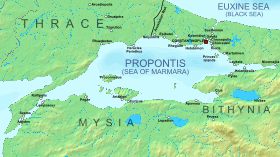Siege of Constantinople (626)
| Avar-Slavic Siege of Constantinople | |||||||
|---|---|---|---|---|---|---|---|
| Part of Byzantine-Sassanid War of 602–628 and the Avar–Byzantine Wars | |||||||
 Depiction of the siege from the Chronicle of Constantine Manasses | |||||||
| |||||||
| Belligerents | |||||||
| Byzantine Empire |
Avar Khaganate Sassanid Empire | ||||||
| Commanders and leaders | |||||||
|
Patriarch Sergius Magister Bonus |
Unnamed Avar khagan Shahrbaraz Kardarigan | ||||||
| Strength | |||||||
| 12,000 men |
80,000 Avars and Slavs, Persian allies | ||||||
| ||||||
The Siege of Constantinople in 626 by the Avars, aided by large numbers of allied Slavs and the Sassanid Persians, ended in a strategic victory for the Byzantines. The failure of the siege saved the Empire from collapse, and, combined with other victories achieved by Emperor Heraclius (r. 610–641) the previous year and in 627, enabled Byzantium to regain her territories and end the destructive Roman-Persian Wars by enforcing a favorable treaty with borders status quo circa 590.
Background
In 602, Phocas overthrew Maurice (r. 582–602), the incumbent Byzantine emperor, and established a reign of terror and incompetence, leading the Empire into anarchy.[1] Laws were passed condemning Jews whilst religious and administrative mishandling left the Empire in a sorry state when the Sassanid king Khosrau II (r. 590–628) attacked, using the coup as a pretext for war. Initially, the war went well for the Persians, until only Anatolia remained in Roman hands. Later, Phocas was overthrown by the son of the then Exarch of Carthage, Heraclius.[1] A general of astounding energy yet limited experience, Heraclius immediately began undoing much of Phocas's damaging work that he had procured whilst Emperor.[1] Yet, despite his offensives into Mesopotamia (modern-day Iraq) Heraclius was unable to stop his Persian enemies from laying siege to his capital where from Chalcedon they were able to launch their attack. From 14–15 May 626, riots in Constantinople against John Seismos occurred because he wanted to cancel the bread rations of the scholae or imperial guards and raise the cost of bread from 3 to 8 follis. He did this to conserve government resources, but he was removed. However, there were further disturbances in the city.[2]
Siege

Also assisting in the siege was a host of 80,000 Avars and Slavs (then submitted to Avars), bent on removing all Roman/Byzantine imperial rule over Europe.[3] The Persians had arrived in Chalcedon before Phocas was overthrown. However, it was only when the Avars began moving forward heavy siege equipment towards the Theodosian Walls that a siege became clear.
Fortunately for the defenders, the soldiers of the capital numbered some 12,000 and consisted of cavalry - normally a well-trained arm of the Greco-Roman army at the time.[4] Adding no small bonus was the Patriarch of Constantinople whose cries for religious zeal among the peasantry around Constantinople was made ever more effective by the fact that they were facing heathens.[4] Consequently, every assault became a doomed effort. When the Avar-Slavic fleet and the Persian fleet were sunk in two different naval engagements, the attackers panicked and fled abandoning the siege apparently under the belief that divine intervention had won the day for Byzantium.[4]
Aftermath

The loss came just after news had reached them of yet another Byzantine victory, where Heraclius's brother Theodore scored well against the Persian general Shahin.[4] Following this, Heraclius led an invasion into Mesopotamia once again, defeating another Persian army at Nineveh. Afterwards, he marched on to Ctesiphon where anarchy reigned allowing Heraclius to extract ever more favorable terms as one Persian king was overthrown by another. Eventually, the Persians were obliged to withdraw all armed forces and return Egypt, the Levant and whatever imperial territories of Mesopotamia and Armenia were in Roman hands at the time of an earlier peace treaty in circa 595. The war over, neither the Persians nor the Byzantines would cross swords again until the Arab-Islamic invasion broke the power of both empires.
Assessment
The siege of 626 failed because the Avars did not have the patience or technology to conquer the city. The walls of Constantinople easily defended against the siege towers and engines. Furthermore, the Persians and Slavs did not have a strong enough navy to ignore the sea walls and establish a channel of communication. The lack of supplies for the Avars eventually caused them to abandon the siege.[5]
See also
- Bonus
- Byzantine-Sassanid Wars
- Byzantine-Arab Wars
- Siege of Constantinople (674)
References
Citations
- ↑ 1.0 1.1 1.2 Norwich 1997, p. 90.
- ↑ Kaegi 2003, p. 133.
- ↑ Norwich 1997, p. 92.
- ↑ 4.0 4.1 4.2 4.3 Norwich 1997, p. 93.
- ↑ Kaegi 2003, p. 140.
Sources
- Norwich, John Julius (1997). A Short History of Byzantium. New York, New York: Alfred A. Knoff. ISBN 0-679-45088-2.
- Kaegi, Walter Emil (2003). Heraclius: Emperor of Byzantium. Cambridge, United Kingdom: Cambridge University Press. ISBN 0-521-81459-6.
Further reading
- Howard-Johnston, James (1995). "The Siege of Constantinople in 626". In Mango, Cyril; Dagron, Gilbert; Greatrex, Geoffrey. Constantinople and its Hinterland: Papers from the Twenty-seventh Spring Symposium on Byzantine Studies, Oxford, April 1993. Aldershot, Hampshire: Variorum. pp. 131–142. ISBN 0-86078-487-8.
- Kazhdan, Alexander Petrovich, ed. (1991). The Oxford Dictionary of Byzantium. New York, New York and Oxford, United Kingdom: Oxford University Press. ISBN 978-0-19-504652-6.
- Treadgold, Warren (1997). A History of the Byzantine State and Society. Stanford, California: Stanford University Press. ISBN 0-8047-2630-2.
External links
| Wikimedia Commons has media related to Siege of Constantinople (626). |